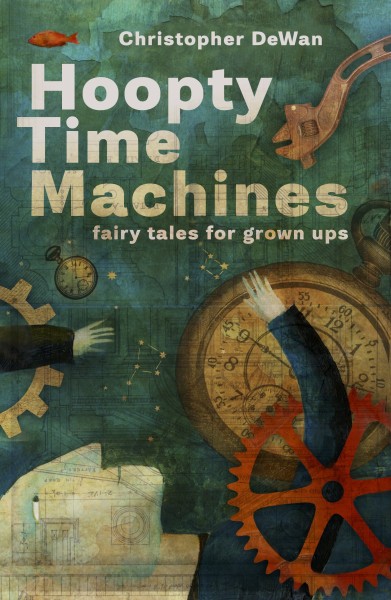
by Amanda Krupman
Christopher DeWan, in his debut flash fiction collection, Hoopty Time Machines (Atticus Books, September 2016), creates new “fairy tales for grownups.” Fairy tales, fables, myths, and parables: These are formative narratives, extracting magic from the sensical and then putting that magic back to work. Told and retold, the tales are palimpsests, utilizing deceptively spare structures and loosely associated archetypes. DeWan’s flash fictions are indeed grown-up stories, built on contemporary anxieties. With this collection he joins writers like Donald Barthelme, Kelly Link, Etger Keret, and Carmen Maria Machado in crafting satirical and sly postmodern fabulism that doesn’t so much aim to subvert fairy-tale tropes as much as uproot them and toss them on the compost pile.
Hoopty Time Machine is 45 stories, arriving just prior to the election of another 45—a U.S. President who doesn’t seem so far removed from the Biblical and Grimm villainy of snakes, ogres, and evil stepmothers. Escape fantasies from the age of late capitalism, a superhero’s existential crisis, a son being the only person who can see his estranged parents are trolls, a mother haunted by her murdered child’s ghost and a father disturbed by his witchy teenage daughter’s power—these are some of the 21st-century scenes animated by DeWan’s dark whimsy.
DeWan’s disillusioned female characters are particularly well conceived. In stories like “Goldilocks and the Three Boys” and “The Little Mermaid,” DeWan doesn’t just offer feminist reappraisals of their fates; he imagines them as the complex, brilliant women all of us know in real life, just trying to get along the best they know how. In “Rapunzel’s Tangles,” Rapunzel, an introverted stay-at-home mom forced to play hostess at her husband’s work parties, cuts off her hair in a bob every day only to find it wrapping around the kitchen by nightfall. She has the same problem with her eyebrows, but she finds grooming them to be a kind of meditative hobby she compares to gardening. And yet Rapunzel’s meditations may better be described as a depressive’s ruminations:
Her worries receded into the simple task: tweeze and pluck. Tweeze and pluck. So close to the glass, her face ceased to be hers, and instead became its own landscape—her own face, a faceless alien landscape of pores and follicles, and staring longer, this dissolved further into just shapes, colors, no labels, no words.
A few of the stories work more like a Stephen Wright joke or a Woody Allen anecdote. “Conestoga Wagon” and “Sacramento” are essentially paraprosdokians, ready to be inserted into a certain kind of stand-up comic’s bit. In “The Dinner Party,” guests include Anxiety, Sadness, and Futility. “Indestructible” is five lines of gallows humor in the age of craven politicians who would dismantle the Affordable Care Act.
Other stories in the collection set aside dry wit and dig deeper under the skin. In “The Wallpaper,” rose-colored glasses are too transparent for a woman who papers over her life. In “Intrusion,” a woman turns to masochism in the face of unbearable grief—leading her to, in a stranger-rape role play, ensure a “hate fuck” from her husband by offering the name of their dead child when he asks for a safe word. In “The Signal,” humanity is initially buoyant but then bereft when realizing that the signals sent to us from alien life forms were sent back in the Middle Ages and that any conversation is subject to a thousand-year time lag.
It’s a fecund period for post-apocalyptic stories; joining popular works from television, film, and genre fiction are literary novels like Emily St. Mandel’s Station Eleven and Laura Van Den Berg’s Find Me. But when reading DeWan’s “Blog of the Last Man on Earth,” I’m reminded of an elegiac short story by Tess Allard, published last year in the Black Warrior Review: “The World Holds What It Remembers Most,” which imagines a girl on a bike, riding alone in a desolated world, seeking both meaning and solace through memory. In “Blog of the Last Man on Earth,” we read the protagonist’s journal and witness a transformation through loneliness that has him imagining he is speaking fluent French with Amélie (yes, that Amélie). Blog posts at the opening of the story are labeled simply by day and time (“Monday, 3:45 pm”), but soon become vague markers like “Evening” and “Middle of the Night I Think” and, finally, “The Scurf of All Yesterdays.” Some of DeWan’s most striking imagery is found here at the end of the story, when the protagonist, musing that “[l]eft to our own devices, maybe we all become artists,” begins painting over the billboards, creating murals from his recollections of an Earth that no longer exists. The Last Man on Earth remembers all of the small, quotidian, and precious moments like “present wrapping and unwrapping” and “road trips and road trip games,” but then:
I remember the smell of my mother, the tinkling of the mobile ceramic swans over my crib, the cozy caress of the satin baby blanket. I remember, before that, sweeping forests far as the eye could see; thick, rolling oceans; endless, mind-flattening plains. I remember fields coated with mustard gas; the groans of sinking ships; piercing bullets and bayonets and the sticky warmth of my own blood; I remember rounding Cape Horn, scaling Mount Everest, building the Pyramids brick by behemoth brick; I remember Pangaea, and the terrible, explosive rending of the Moon. I remember the ignition of the Sun, and the swirling center of the galaxy, the whip of its arms screaming through the vacuum. I remember the end of infinite density, the Big Bang, a gasp of breath, a baby’s laugh, a cosmic orgasm, the same spasm of anticipation that comes at the dawn of love, the true fear of loss; and I remember, before all that, the bottomless, bottomless silence like the silence I hear now. It’s all right.
DeWan’s protagonist no longer has any use for his personhood, for what makes him an individual. He strips it all away in favor of painting pictures of scenes from an ancient, collective memory.
In a rich collection of flash, Hoopty Time Machines mines our collective memory and imaginatively spins multilayered versions of stories that have been developed and adapted over generations: stories that live in our bodies, attached to the spine, keeping us upright as we move through the obstinate moment-to-moment and often terrifying unknowns of what’s yet to come.
________________________
 Amanda Krupman’s work has appeared in publications including Flapperhouse, The Forge Literary Magazine, BLOOM, The New Engagement, and Punk Planet. Amanda received an MFA in Fiction from The New School’s graduate writing program and was recently a recipient of a Jerome Foundation Emerging Artist Residency Award. She teaches writing at Pace University and “From Page to Podcast: Writing Audio Fiction” at Middlebury College. She is currently working on a collection of short fiction. Follow her on Twitter: @akrupman
Amanda Krupman’s work has appeared in publications including Flapperhouse, The Forge Literary Magazine, BLOOM, The New Engagement, and Punk Planet. Amanda received an MFA in Fiction from The New School’s graduate writing program and was recently a recipient of a Jerome Foundation Emerging Artist Residency Award. She teaches writing at Pace University and “From Page to Podcast: Writing Audio Fiction” at Middlebury College. She is currently working on a collection of short fiction. Follow her on Twitter: @akrupman

 The core workshop of SmokeLong Fitness is all in writing, so you can take part from anywhere at anytime. We are excited about creating a supportive, consistent and structured environment for flash writers to work on their craft in a community. We are thrilled and proud to say that our workshop participants have won, placed, or been listed in every major flash competition. Community works.
The core workshop of SmokeLong Fitness is all in writing, so you can take part from anywhere at anytime. We are excited about creating a supportive, consistent and structured environment for flash writers to work on their craft in a community. We are thrilled and proud to say that our workshop participants have won, placed, or been listed in every major flash competition. Community works.